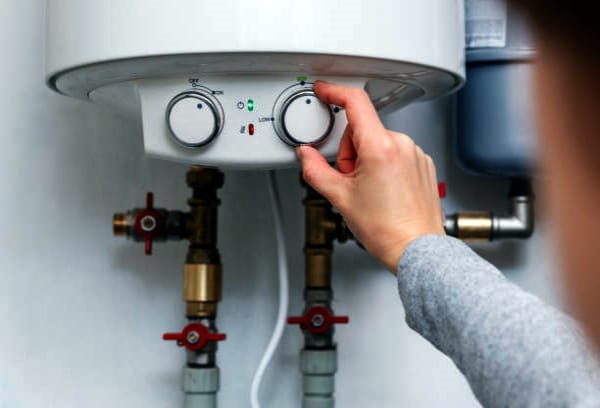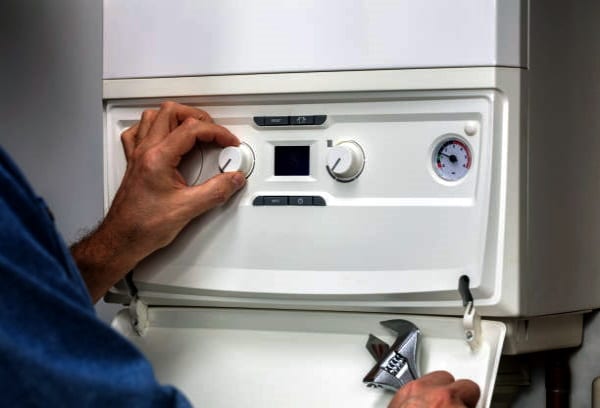Taking proper care of your water heater is the key to increasing its lifespan and saving money. Regular inspections of your unit’s components for any degradation like rust, leaks or unusual sounds are essential, as these may indicate potential problems. For instance, a faint hissing sound from the pressure relief valve or signs of discoloration around the heating element could signify trouble brewing; that’s not common knowledge for many.
Make sure you’re not missing out on professional maintenance checks regularly, as skipping them can escalate unnoticed water heater issues, causing serious damage and expense. After all, ensuring that a trusted technician takes a look at your heater now and then will keep it running smoothly without a problem. Check out the expert tips on water heater maintenance!
Properly Inspect Your Water Heater Components
Regularly examining your water heater is similar to giving it a doctor’s check-up. With each inspection, you afford yourself the opportunity to catch problems early and address them before they escalate. Carefully looking for signs of wear and tear, such as corrosion, leaks, rust, or unusual noises, is imperative.
When inspecting the tank, pay close attention to the area around the pressure relief valve, the pipes connecting to the tank, and the heating element. Check for any signs of moisture around these components, as this might be an indication of a leak.
In addition to visually inspecting for signs of damage, listening for abnormal sounds or noticing any unusual smells near the water heater is also crucial. These can be indicators of potential issues that must be addressed promptly.
For instance, a rumbling noise coming from your water heater could signal a significant buildup of sediment in the tank. Addressing this issue early on can stave off more severe problems down the line and extend the lifespan of your water heater.
Proper inspection grants peace of mind and serves as a cost-saving option by avoiding potentially costly repairs in the future.
Regular Professional and Manufacturer Checks
Allowing a professional to look over your water heater can really help. They have special tools and know what clues to look for that might indicate trouble down the road. For example, they may be able to detect early signs of corrosion or mineral buildup, which, if left unattended, can lead to more serious issues such as leaks or damage to the heating elements.
Not only do these checks save you from costly repairs in the long run, but they also ensure that your water heater is operating efficiently. It’s like giving your water heater an extended lease on life.
These professional checks are also crucial for maintaining your warranty. Many times, warranties specify that the water heater must undergo servicing at specific intervals by a licensed professional in order to remain valid.
It’s always wise to comply with these recommendations laid out by the manufacturer because it not only ensures your unit remains in top working condition but also safeguards you against potentially voiding your warranty inadvertently.
Lastly, don’t forget about the peace of mind that comes with knowing that your water heater is looked after by a professional, allowing you to trust that your unit is in good hands.
Flushing Out Tank Sediment and Debris
Your water heater can get weighed down by sediment and debris buildup in its tank. This buildup can seriously affect its performance, making it work much harder to heat the water. Regularly flushing the tank can give your water heater room to breathe and perform at its best.
But what is this sediment made of? Well, when water rises in temperature, some dissolved minerals might fall out and sink to the bottom of the tank. Over time, these sediments accumulate into a dense layer, taking up space that could be used for heating water effectively. As this layer thickens, it forces your water heater to use more energy, which raises your utility bills. Additionally, water heaters with too much sediment have a higher chance of developing leaks or other damage. It’s important to note that not all water heaters will gather sediment at the same rate—this depends on various factors, such as the hardness of your local water supply.
The good news is that you don’t have to stand by while your water heater suffers from all this weight! Flushing out the tank annually can remove these sediments and help your water heater operate more efficiently. An added bonus is that shorter working periods mean less wear and tear on your entire water heating system, leading to fewer repairs and longer equipment lifespans.
Steps for Flushing Out Tank Sediment
- Turn off the power supply—this could mean turning off the gas valve if you have a gas water heater or switching off the circuit breaker if you have an electric one.
- Attach a garden hose to the drain valve located near the bottom of the tank.
- Open a hot water tap somewhere nearby – this will relieve pressure in the system.
- Open the drain valve and let the water gush out for about 5–10 minutes until it runs clear.
- Close everything back up once done, turn on the cold-water supply to refill the tank, and finally turn on the power supply.
With regular checks in place and occasional flushing-out sessions, your trusty water heater will be working like a pro—that means reliable hot water whenever you need it, lower energy costs, and a prolonged lifespan for your system.
Temperature and Pressure Controls
Your water heater has its own internal environment and, like any system, it needs to be monitored for signs of trouble. By understanding and managing the temperature and pressure within it, you can ensure not only a longer lifespan for your water heater but also significant energy savings.
First off, let’s talk about the temperature settings. It’s tempting to crank up the heat to have piping hot water available at all times, but that can lead to energy waste and potential safety hazards. By setting the temperature to be between 120-125 degrees Fahrenheit, you not only prevent the risk of scalding but also reduce energy consumption. With every 10°F reduction in water temperature, you can save between 3-5% in energy costs, making it a practical and efficient choice.
In addition to managing the temperature, it is crucial to test the functionality of the pressure relief valve. This small but mighty component plays a vital role in preventing excessive pressure buildup that could result in catastrophic failures. Therefore, testing this valve should not be neglected as part of regular maintenance.
By ensuring the proper functioning of both the temperature and pressure relief systems, you are not only contributing to a longer life for your water heater but also maintaining a level of safety that is well worth the minimal effort required for these regular checks.
Insulating Your Water Heater
Water heaters, especially those in colder environments or unheated areas, can lose heat significantly. This isn’t just about comfort; it’s about maximizing the unit’s lifespan while keeping energy costs in check. Proper insulation minimizes heat loss, thus reducing the workload on the water heater.
The good news is that insulating your water heater isn’t as complex as it might sound. This process involves wrapping a special insulating blanket around the tank to retain the heat inside. Additionally, this step prevents condensation formation on the outside of the tank when warm air touches the cold metal surface—a process that can lead to corrosion over time.
Moreover, insulating the hot water pipes complements this effort by ensuring that once hot water leaves the tank, it stays warm on its journey to your faucet without cooling down too quickly inside chilly pipes.
Pipe insulation comes in different forms, like foam sleeves or wraps, and is easy to install by simply slipping them onto exposed sections of piping. This ensures that you’re using energy efficiently and not wasting any extra heating capacity on warming up cold pipes—all contributing to a longer water heater lifespan and more savings on your energy bill in the long run.
Enhancing the effectiveness of your water heater doesn’t stop here; there are specific strategies tailored for tankless water heaters that can further improve their performance.
Special Tips for Tankless Water Heater Maintenance
Tankless water heaters might be low maintenance overall, but they do require specific care to keep running smoothly and efficiently. One of the most crucial tasks is descaling, especially in areas where hard water is prevalent. Descaling helps to remove mineral buildup inside the heater.
Effects of Hard Water on Tankless Water Heaters
Hard water contains high levels of minerals such as calcium and magnesium. When these minerals are heated, they can form a scale on the insides of pipes and equipment. Over time, this mineral buildup can affect the performance of your tankless water heater by reducing its efficiency.
Furthermore, ensuring a consistent flow of water is important to keep the heater functioning properly. Tankless water heaters rely on a steady flow of water to work effectively. If there are any irregularities with the flow, it can lead to issues with heating and affect the overall lifespan of the heater.
Another crucial aspect is regular filter cleaning. Filters prevent debris from entering the water heater system and causing damage. By keeping the filters clean, you ensure an uninterrupted flow of water while also protecting the heater from potential harm.
The specialized care needed for tankless water heaters emphasizes their unique needs compared to traditional tank-based water heaters. If you’re looking for professional checks or need assistance with maintaining your tankless water heater, reaching out to our local plumbing business at Prospector Plumbing and Heating could be incredibly beneficial in ensuring your system runs at its optimal level. Schedule your appointment with us.


